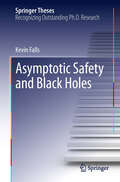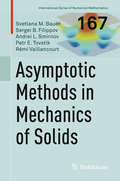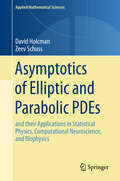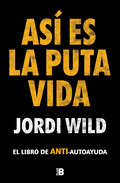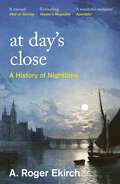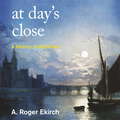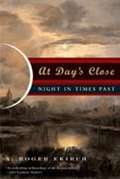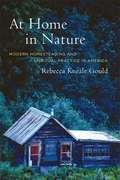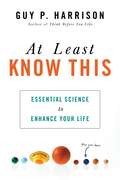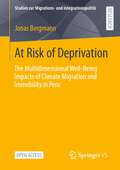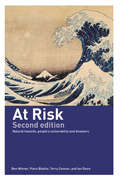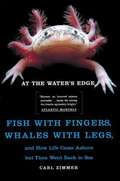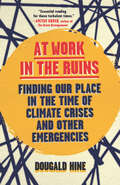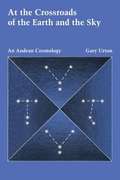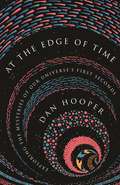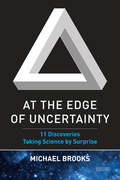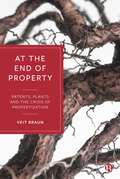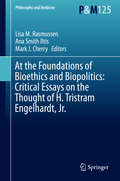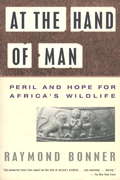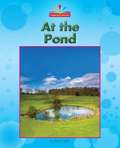- Table View
- List View
Asymptotic Perturbation Methods: For Nonlinear Differential Equations in Physics
by Attilio MaccariAsymptotic Perturbation Methods Cohesive overview of powerful mathematical methods to solve differential equations in physics Asymptotic Perturbation Methods for Nonlinear Differential Equations in Physics addresses nonlinearity in various fields of physics from the vantage point of its mathematical description in the form of nonlinear partial differential equations and presents a unified view on nonlinear systems in physics by providing a common framework to obtain approximate solutions to the respective nonlinear partial differential equations based on the asymptotic perturbation method. Aside from its complete coverage of a complicated topic, a noteworthy feature of the book is the emphasis on applications. There are several examples included throughout the text, and, crucially, the scientific background is explained at an elementary level and closely integrated with the mathematical theory to enable seamless reader comprehension. To fully understand the concepts within this book, the prerequisites are multivariable calculus and introductory physics. Written by a highly qualified author with significant accomplishments in the field, Asymptotic Perturbation Methods for Nonlinear Differential Equations in Physics covers sample topics such as: Application of the various flavors of the asymptotic perturbation method, such as the Maccari method to the governing equations of nonlinear system Nonlinear oscillators, limit cycles, and their bifurcations, iterated nonlinear maps, continuous systems, and nonlinear partial differential equations (NPDEs) Nonlinear systems, such as the van der Pol oscillator, with advanced coverage of plasma physics, quantum mechanics, elementary particle physics, cosmology, and chaotic systems Infinite-period bifurcation in the nonlinear Schrodinger equation and fractal and chaotic solutions in NPDEs Asymptotic Perturbation Methods for Nonlinear Differential Equations in Physics is ideal for an introductory course at the senior or first year graduate level. It is also a highly valuable reference for any professional scientist who does not possess deep knowledge about nonlinear physics.
Asymptotic Safety and Black Holes (Springer Theses)
by Kevin FallsOne of the open challenges in fundamental physics is to combine Einstein's theory of general relativity with the principles of quantum mechancis. In this thesis, the question is raised whether metric quantum gravity could be fundamental in the spirit of Steven Weinberg's seminal asymptotic safety conjecture, and if so, what are the consequences for the physics of small, possibly Planck-size black holes? To address the first question, new techniques are provided which allow, for the first time, a self-consistent study of high-order polynomial actions including up to 34 powers in the Ricci scalar. These novel insights are then exploited to explain quantum gravity effects in black holes, including their horizon and causal structure, conformal scaling, evaporation, and the thermodynamics of quantum space-time. Results indicate upper limits on black hole temperature, and the existence of small black holes based on asymptotic safety for gravity and thermodynamical arguments.
Asymptotic methods in mechanics of solids (International Series of Numerical Mathematics #167)
by Svetlana M. Bauer Sergei B. Filippov Andrei L. Smirnov Petr E. Tovstik Rémi VaillancourtThe construction of solutions of singularly perturbed systems of equations and boundary value problems that are characteristic for the mechanics of thin-walled structures are the main focus of the book. The theoretical results are supplemented by the analysis of problems and exercises. Some of the topics are rarely discussed in the textbooks, for example, the Newton polyhedron, which is a generalization of the Newton polygon for equations with two or more parameters. After introducing the important concept of the index of variation for functions special attention is devoted to eigenvalue problems containing a small parameter. The main part of the book deals with methods of asymptotic solutions of linear singularly perturbed boundary and boundary value problems without or with turning points, respectively. As examples, one-dimensional equilibrium, dynamics and stability problems for rigid bodies and solids are presented in detail. Numerous exercises and examples as well as vast references to the relevant Russian literature not well known for an English speaking reader makes this a indispensable textbook on the topic.
Asymptotics of Elliptic and Parabolic PDEs: And Their Applications In Statistical Physics, Computational Neuroscience, And Biophysics (Applied Mathematical Sciences #199)
by Zeev Schuss David HolcmanThis is a monograph on the emerging branch of mathematical biophysics combining asymptotic analysis with numerical and stochastic methods to analyze partial differential equations arising in biological and physical sciences. In more detail, the book presents the analytic methods and tools for approximating solutions of mixed boundary value problems, with particular emphasis on the narrow escape problem. Informed throughout by real-world applications, the book includes topics such as the Fokker-Planck equation, boundary layer analysis, WKB approximation, applications of spectral theory, as well as recent results in narrow escape theory. Numerical and stochastic aspects, including mean first passage time and extreme statistics, are discussed in detail and relevant applications are presented in parallel with the theory. Including background on the classical asymptotic theory of differential equations, this book is written for scientists of various backgrounds interested in deriving solutions to real-world problems from first principles.
Así es la puta vida: El libro de ANTI-autoayuda
by Jordi WildEl esperado libro de Jordi Wild, uno de los youtubers más populares de España y creador de The Wild Project, el pódcast más escuchado. Ni eres el centro del universo ni todos tus sueños van a cumplirse. Olvídate de las chorradas de los libros de autoayuda y de los gurús baratos que intentan hacerte creer que «si quieres, puedes»; de los crypto bros que te harán millonario sin trabajar y de los que te dicen que seas tu propio jefe mientras se graban en la piscina de la casa de sus padres. Aquí no encontrarás recetas mágicas ni los cinco pasos que tienes que seguir para SER FELIZ. Eso se lo dejo a los que se quieren aprovechar de ti. En este libro te voy a contar lo que para mí es la vida de verdad, sin edulcorantes ni azúcares añadidos; la jodida (y maravillosa) lucha que tienes que librar cada día para poder disfrutar y realizarte. La vidate dará una buena somanta de hostias, eso es inevitable, pero de ti depende levantarte y seguir guerreando. Vale la pena, te lo aseguro. ASÍ ES LA PUTA VIDA. ESPERO QUE ESTÉS PREPARADO PARA ACEPTARLO.
At Day's Close: A History of Nighttime
by A. Roger EkirchA fascinating and colourful social history of the nighttime in the pre-Industrial era.AT DAY'S CLOSE charts a fresh realm of Western culture, nocturnal life from the late medieval period to the Industrial revolution. The book focuses on the cadences of daily life, investigating nighttime in its own right and resurrecting a rich and complex universe in which persons passed nearly half of their lives - a world, long-lost to historians, of blanket fairs, night freaks, and curtain lectures, of sun-suckers, moon-cursers and night-kings. It is not only the vocabulary that has disappeared, AT DAY'S CLOSE will restitute many facts which have been either lost or forgotten. It is a significant and newsworthy contribution to social history, filled with substantial research, stories and new discoveries.Ekirch uses a wide range of sources to reconstruct how the night was lived in the past : travel accounts, memoirs, letters, poems, plays, court records, coroner's reports, depositions and laws dealing with curfews, crime and lighting. He has analysed working-class autobiographies, proverbs, nursery rhymes, ballads and sermons, and folklore, as well as consulting medical, psychological and anthropological papers.
At Day's Close: A History of Nighttime
by Professor A. Roger EkirchA fascinating and colourful social history of the nighttime.'A wonderful revelation of a vanished age of darkness' SPECTATOR'Fascinating' SUNDAY TIMES'A splendid book ... great entertainment' Sir Patrick Moore'A triumph of social history. Almost every page contains something to surprise the reader ... one of the most enjoyable literary experiences of the year' MAIL ON SUNDAYFrom blanket fairs to night kings, curfews to crime, At Day's Close is an intriguing and captivating investigation into the night. Until now, this rich and complex universe in which we spend nearly half of our lives was a world long-lost to historians. Here, Ekirch explores how the night was lived in the past, through travel accounts, memoirs, letters, folklore, poems, court records and coroner's reports. More than this, it is a passionate argument in the case for less artificial light in an increasingly bright world.
At Day's Close: Night In Times Past
by A. Roger EkirchBringing light to the shadows of history through a "rich weave of citation and archival evidence" (Publishers Weekly), scholar A. Roger Ekirch illuminates the aspects of life most often overlooked by other historians--those that unfold at night. In this "triumph of social history" (Mail on Sunday), Ekirch's "enthralling anthropology" (Harper's) exposes the nightlife that spawned a distinct culture and a refuge from daily life. Fear of crime, of fire, and of the supernatural; the importance of moonlight; the increased incidence of sickness and death at night; evening gatherings to spin wool and stories; masqued balls; inns, taverns, and brothels; the strategies of thieves, assassins, and conspirators; the protective uses of incantations, meditations, and prayers; the nature of our predecessors' sleep and dreams--Ekirch reveals all these and more in his "monumental study" (The Nation) of sociocultural history, "maintaining throughout an infectious sense of wonder" (Booklist).
At Home in Nature: Modern Homesteading and Spiritual Practice in America
by Rebecca Kneale GouldThis study of homesteading in America from the late nineteenth century to the present examines the lives and beliefs of those who have ascribed to the homesteading philosophy, placing their experiences within the broader context of the changing meanings of nature and religion in modern American culture.
At Least Know This: Essential Science to Enhance Your Life
by Guy P. HarrisonThis primer on essential scientific literacy gives readers the basics to understand themselves and the world around them, plus a glimpse of how much more science has to offer.Science tells us a good deal about who we are, where we come from, the nature of the universe, how our brains work, and much, much more. Unfortunately, most people are largely unaware of this treasure trove of information. As a result, we are more prone to do things like aim nuclear weapons at each other, inflate the meaning of cultural differences, lay waste to the land, poison and deplete the oceans, fill the sky with carbon, and generally make poor judgments that cause needless trouble.This book seeks to remedy this situation by providing scientific answers to the most basic yet important questions about existence. Following the standard six-question list used by journalists researching a news story, critical-thinking advocate Guy P. Harrison turns to science to answer the who, what, why, when, where and how of life on Earth.How old is our planet? Where did it come from and where is it located in the universe? What is everything made of? When did life begin? Who are we as a species and what connections do we share with other life forms? Why is human culture continuously plagued by war, disease, and crime? Harrison not only offers science's best current answers to these crucial questions but shows how all of this information fits together. Going well beyond the simplistic factoids readily available on any smartphone, he reveals the wider implications and deeper meanings inherent in the scientific worldview.Both entertaining and informative, this exciting tour of the cosmos and human nature will leave readers with an accurate, up-to-date view of realities small and large, near and far.
At Risk of Deprivation: The Multidimensional Well-Being Impacts of Climate Migration and Immobility in Peru (Studien zur Migrations- und Integrationspolitik)
by Jonas BergmannThis open access book examines how and why various forms of climate (im)mobilities can impact people's objective and subjective well-being. Worsening climate impacts are forcing subsistence farmers worldwide to decide between staying or leaving their homes. This mixed methods study analyzes cases of climate-related migration, displacement, relocation, and immobility in Peru's coastal, highland, and rainforest regions. The results reveal that numerous farmers experienced profound and often negative well-being impacts, regardless of whether they stayed or migrated. The higher the structural constraints, such as weak governance, and the more damaging the climate impacts were, the higher the risk of well-being declines. Additionally, the affected individuals often had limited agency and ability to mitigate losses. These findings challenge the notion of "migration as adaptation" and emphasize the importance of safeguarding the human rights and security of those affected while addressing loss and damage. Without significant investments in such efforts, climate impacts could sharply diminish the well-being of numerous subsistence farmers worldwide—irrespective of whether they stay or migrate.
At Risk: Natural Hazards, People's Vulnerability and Disasters
by Ian Davis Ben Wisner Piers Blaikie Terry CannonThe term 'natural disaster' is often used to refer to natural events such as earthquakes, hurricanes or floods. However, the phrase 'natural disaster' suggests an uncritical acceptance of a deeply engrained ideological and cultural myth. At Risk questions this myth and argues that extreme natural events are not disasters until a vulnerable group of people is exposed. The updated new edition confronts a further ten years of ever more expensive and deadly disasters and discusses disaster not as an aberration, but as a signal failure of mainstream 'development'. Two analytical models are provided as tools for understanding vulnerability. One links remote and distant 'root causes' to 'unsafe conditions' in a 'progression of vulnerability'. The other uses the concepts of 'access' and 'livelihood' to understand why some households are more vulnerable than others. Examining key natural events and incorporating strategies to create a safer world, this revised edition is an important resource for those involved in the fields of environment and development studies.
At Risk: Natural Hazards, People's Vulnerability and Disasters
by Ian Davis Ben Wisner Piers Blaikie Terry CannonThe term 'natural disaster' is often used to refer to natural events such as earthquakes, hurricanes or floods. However, the phrase 'natural disaster' suggests an uncritical acceptance of a deeply engrained ideological and cultural myth. At Risk questions this myth and argues that extreme natural events are not disasters until a vulnerable group of people is exposed. The updated new edition confronts a further ten years of ever more expensive and deadly disasters and discusses disaster not as an aberration, but as a signal failure of mainstream 'development'. Two analytical models are provided as tools for understanding vulnerability. One links remote and distant 'root causes' to 'unsafe conditions' in a 'progression of vulnerability'. The other uses the concepts of 'access' and 'livelihood' to understand why some households are more vulnerable than others. Examining key natural events and incorporating strategies to create a safer world, this revised edition is an important resource for those involved in the fields of environment and development studies.
At The Water's Edge: Fish With Fingers, Whales With Legs, and How Life Came Ashore But Then Went Back To Sea
by Carl Zimmer Carl Dennis BuellEverybody Out of the Pond: At the Water's Edge will change the way you think about your place in the world. The awesome journey of life's transformation from the first microbes 4 billion years ago to Homo sapiens today is an epic that we are only now beginning to grasp. Magnificent and bizarre, it is the story of how we got here, what we left behind, and what we brought with us. We all know about evolution, but it still seems absurd that our ancestors were fish. Darwin's idea of natural selection was the key to solving generation-to-generation evolution -- microevolution -- but it could only point us toward a complete explanation, still to come, of the engines of macroevolution, the transformation of body shapes across millions of years. Now, drawing on the latest fossil discoveries and breakthrough scientific analysis, Carl Zimmer reveals how macroevolution works. Escorting us along the trail of discovery up to the current dramatic research in paleontology, ecology, genetics, and embryology, Zimmer shows how scientists today are unveiling the secrets of life that biologists struggled with two centuries ago. In this book, you will find a dazzling, brash literary talent and a rigorous scientific sensibility gracefully brought together. Carl Zimmer provides a comprehensive, lucid, and authoritative answer to the mystery of how nature actually made itself.
At Work in the Ruins: Finding Our Place in the Time of Climate Crises and Other Emergencies
by Dougald Hine&‘One of the most perceptive and thought-provoking books …Essential reading for these turbulent times.&’ Amitav Ghosh, author of The Great Derangement&‘Dougald Hine&’s brilliant book demands we stare into that abyss and rethink our securest certainties about what is actually going on in the climate crisis. It&’s lucidly unsettling and yet in the end empowering. There is something we can do, and it starts with where we look, how we see and what we choose to change.&’ Brian Eno, Musician&‘[A] rich book, which like a poetic or religious text deserves multiple readings&’ Richard Smith, British Medical Journal&‘I consider this book a must-read for all those activists feeling lost, desperate and perhaps subject to &‘press-on-itis&’.&’ Gail Bradbrook, cofounder, Extinction RebellionDougald Hine, world-renowned environmental thinker, has spent most of his life talking to people about climate change. And then one afternoon in the second year of the pandemic, he found he had nothing left to say. Why would someone who cares so deeply about ecological destruction want to stop talking about climate change now? At Work in the Ruins explores that question.&‘Climate change asks us questions that climate science cannot answer,&’ Dougald says. Questions like, how did we end up in this mess? Is it just a piece of bad luck with atmospheric chemistry – or is it the result of a way of approaching the world that would always have brought us to such a pass? How we answer such questions also has consequences.Through our over-reliance on the single lens of science, Dougald writes that we are blinded to the nature of the crises around and ahead of us, leading to &‘solutions&’ that can only make things worse. At Work in the Ruins is his reckoning with the strange years we have been living through and our long history of asking too much of science. He offers guidance by standing firmly forward and facing the depth of the trouble we are in, to ultimately, helps us find the work that is worth doing, even in the ruins.
At the Crossroads of the Earth and the Sky: An Andean Cosmology
by Gary UrtonBased on fieldwork in Misminay, Peru, Gary Urton details a cosmology in which the Milky Way is central. This is the first study that provides a description and analysis of the astronomical and cosmological system in a contemporary community in the Americas.
At the Edge of Time: Exploring the Mysteries of Our Universe’s First Seconds (Science Essentials #32)
by Dan HooperA new look at the first few seconds after the Big Bang—and how research into these moments continues to revolutionize our understanding of our universeScientists in the past few decades have made crucial discoveries about how our cosmos evolved over the past 13.8 billion years. But there remains a critical gap in our knowledge: we still know very little about what happened in the first seconds after the Big Bang. At the Edge of Time focuses on what we have recently learned and are still striving to understand about this most essential and mysterious period of time at the beginning of cosmic history.Taking readers into the remarkable world of cosmology, Dan Hooper describes many of the extraordinary and perplexing questions that scientists are asking about the origin and nature of our world. Hooper examines how we are using the Large Hadron Collider and other experiments to re-create the conditions of the Big Bang and test promising theories for how and why our universe came to contain so much matter and so little antimatter. We may be poised to finally discover how dark matter was formed during our universe’s first moments, and, with new telescopes, we are also lifting the veil on the era of cosmic inflation, which led to the creation of our world as we know it.Wrestling with the mysteries surrounding the initial moments that followed the Big Bang, At the Edge of Time presents an accessible investigation of our universe and its origin.
At the Edge of Uncertainty: 11 Discoveries Taking Science by Surprise
by Michael BrooksThe bestselling author of Free Radicals takes readers on a whirlwind tour of the most controversial areas of modern science The atom. The Big Bang. DNA. Natural selection. All are ideas that have revolutionized science--and all were dismissed out of hand when they first appeared. The surprises haven't stopped in recent years, and in At the Edge of Uncertainty, bestselling author Michael Brooks investigates the new wave of radical insights that are shaping the future of scientific discovery. Brooks takes us to the extreme frontiers of what we understand about the world. He journeys from the observations that might rewrite our story of how the cosmos came to be, through the novel biology behind our will to live, and on to the physiological root of consciousness. Along the way, he examines how it's time to redress the gender imbalance in clinical trials, explores how merging humans with other species might provide a solution to the shortage of organ donors, and finds out whether the universe really is like a computer or if the flow of time is a mere illusion.
At the End of Property: Patents, Plants and the Crisis of Propertization
by Veit BraunRecent decades have witnessed the creation of new types of property systems, ranging from data ownership to national control over genetic resources. This trend has significant implications for wealth distribution and our understanding of who can own what. This book explores the idea of ownership in the realm of plant breeding, revealing how plants have been legally and materially transformed into property. It highlights the controversial aspects of turning seeds, plants and genes into property and how this endangers the viability of the seed industry. Examining ownership not simply as a legal concept, but as a bundle of laws, practices and technologies, this is a valuable contribution that will interest scholars of intellectual property studies, the anthropology of markets, science and technology studies and related fields.
At the Foundations of Bioethics and Biopolitics: Critical Essays on the Thought of H. Tristram Engelhardt, Jr. (Philosophy and Medicine #125)
by Lisa M. Rasmussen Ana Iltis Mark J. CherryThis volume brings together a set of critical essays on the thought of Professor Doctor H. Tristram Engelhardt Junior, Co-Founding Editor of the Philosophy and Medicine book series. Amongst the founders of bioethics, Professor Engelhardt, Jr. looms large. Many of his books and articles have appeared in multiple languages, including Italian, Romanian, Portuguese, Spanish, and Chinese. The essays in this book focus critically on a wide swath of his work, in the process elucidating, critiquing, and/or commending the rigor and reach of his thought. This volume compasses analyses of many different aspects of Engelhardt's work, including social and political philosophy, biopolitics, the philosophy of medicine, and bioethics. It brings together internationally known scholars to assess key elements of Engelhardt's work.
At the Frontier of Spacetime: Scalar-Tensor Theory, Bells Inequality, Machs Principle, Exotic Smoothness (Fundamental Theories of Physics #183)
by Torsten Asselmeyer-MalugaIn this book, leading theorists present new contributions and reviews addressing longstanding challenges and ongoing progress in spacetime physics. In the anniversary year of Einstein's General Theory of Relativity, developed 100 years ago, this collection reflects the subsequent and continuing fruitful development of spacetime theories. The volume is published in honour of Carl Brans on the occasion of his 80th birthday. Carl H. Brans, who also contributes personally, is a creative and independent researcher and one of the founders of the scalar-tensor theory, also known as Jordan-Brans-Dicke theory. In the present book, much space is devoted to scalar-tensor theories. Since the beginning of the 1990s, Brans has worked on new models of spacetime, collectively known as exotic smoothness, a field largely established by him. In this Festschrift, one finds an outstanding and unique collection of articles about exotic smoothness. Also featured are Bell's inequality and Mach's principle. Personal memories and historical aspects round off the collection.
At the Hand of Man
by Raymond BonnerDefying conventional wisdom even as it makes an impassioned plea for moral common sense, this book by an award-winning journalist sheds a new light on the history and politics of the African conservation movement. The book will anger and inspire anyone who cares about African wildlife and the people whose future is intertwined with the fate of these animals.
At the Heart of the Coral Triangle: Celebrating Biodiversity
by Alan J Powderham Sancia van der MeijThe Coral Triangle, straddling the confluence of the Indian and Pacific Oceans, harbours the greatest biodiversity of marine life on the planet. It is home to a wondrous variety, including 75% of the world's coral species and around 2500 species of fish. The biological and environmental diversity is driven by the volcanically active and complex geology of the so called 'Ring of Fire'. Habitats range from underwater slopes of volcanic black sand to extensive coral reefs in atolls and vast calderas. While clearly vulnerable to increasing global threats such as climate change, pollution and overfishing, the Coral Triangle currently features some the richest coral reefs in the world. With stunning photography supported by an engaging and accessible text, this book highlights and celebrates this biodiversity along with the underlying message that it needs our care and protection before it is too late.
At the Pond
by Mary Lindeen"Take a trip to a pond. See fish, cattails, dragonflies, turtles, and other interesting plants and animals that live there. Take a ride in the water on a canoe. You never know what you'll find at a pond! This informational text, nonfiction BeginningtoRead book contains highfrequency words and content vocabulary. This book can be paired with What's in the Pond, Dear Dragon?, its twin text fiction counterpart. Reading reinforcement pages include a word list and activities to strengthen early literacy skills, such as understanding the craft and structure of informational text, key vocabulary words, foundation skills, close reading, and fluency. Aligns with English Language Arts Standards for Grades K3. "
At the Root of It
by Robert NewellWhat grow underground and are strong enough to break through rock? The answer is roots. Roots are an amazing part of plants and trees. At the Root of It explains how roots work hard so plants and trees survive and grow.

